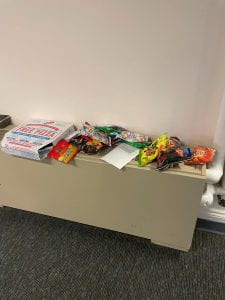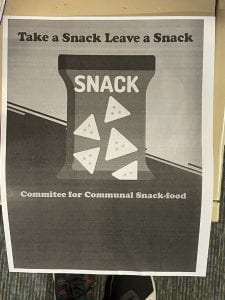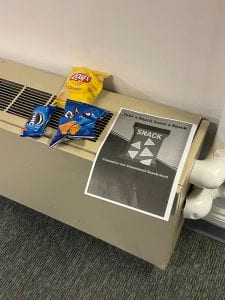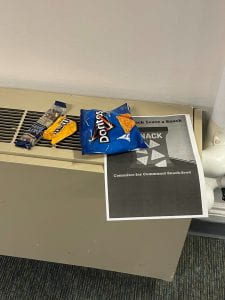When I began thinking of possible interventions for my project, I thought back to a story of how someone at my residence hall ordered delivery from Chipotle hall only to find it stolen. College is expensive, so its understandable that many students try to save money as much as possible, and while theft is absolutely not pervasive behavior, students are still notorious for going to great lengths to come by free food. Many of my friends have swung by booths and loaded up on free food and drinks being given out even if they absolutely hate the items. I felt that this relationship between college students and food was an excellent situation to intervene in.
One inspiration for my piece was inspired by the Jejune Institute ARG, specifically the elements where participants where given specific instructions to perform on their own. I also drew from the work of the Yes Men, as I enjoyed how their work involved intervening in public contexts.
My test piece was simple, I laid out an array of snacks alongside a handwritten note instructing for fellow students at the residential hall to take a snack and then leave a snack. I set this up in the residential hall’s basement, which is the area where the most students pass through. Since there are no actual tables down there I set the snacks up on a radiator. The goal of the intervention was to look at how students would act without supervision, so I left the snacks completely unattended until I checked on them. I wanted to see if people would follow the instructions and trade in a snack for one on the radiator or if they would simply take them. Most people who give out food on campus usually do so with ulterior motives, like trying to get people to join an organization, so I thought it would be interesting to create a situation where food is made accessible with seemingly no motive outside of building community. (Although staging an intervention is definitely an ulterior motive).

This is the arrangement I made for my test run
To my surprise when I came back 6 hours later to check on the snacks I found that there was actually more than I had initially left!

While some snacks like some Hostess pastries and Hi-chews had been taken, a plethora of new snacks had replaced them and more.
For my “final” iteration of this experiment, I noticed that the snack food that had been taken the first time were snacks that are generally considered to be higher end. With that in mind I decided to vary up the quality of the snacks to see if the better snacks were taken first.

Alongside more generic snack foods like potato chips and Oreos I placed higher quality (and more expensive) snacks like Milano’s, chocolate oranges, and Hi-chews.
Another change I made was to the note. The note I left in the first one was very informal, as it was made by nothing more than scrap paper and the first pen I could find. I made a more formal note in photoshop to see if it would affect how people interacted with the instructions.

After a few hours I went back to the snack arrangement and found that all of the “higher end” snacks were gone, with nothing to replace them.

However the most interesting occurrence I discovered at the end of the test day.

When the higher end snacks were gone, people actually followed the instructions of the note and traded in a snack for a snack.
I find the results of this intervention to be incredibly interesting. It seems that when the arrangement seemed more informal —with a handwritten note and cheaper snacks as a whole— people were more willing to not only follow the instructions, but actually support the project by donating foods without taking any away. However when the arrangement seemed more formal, with better snacks and a designed note, people were less willing to follow along as a whole. Another interesting occurrence is that when only the more generic foods were left people were once again willing to follow the instructions.
